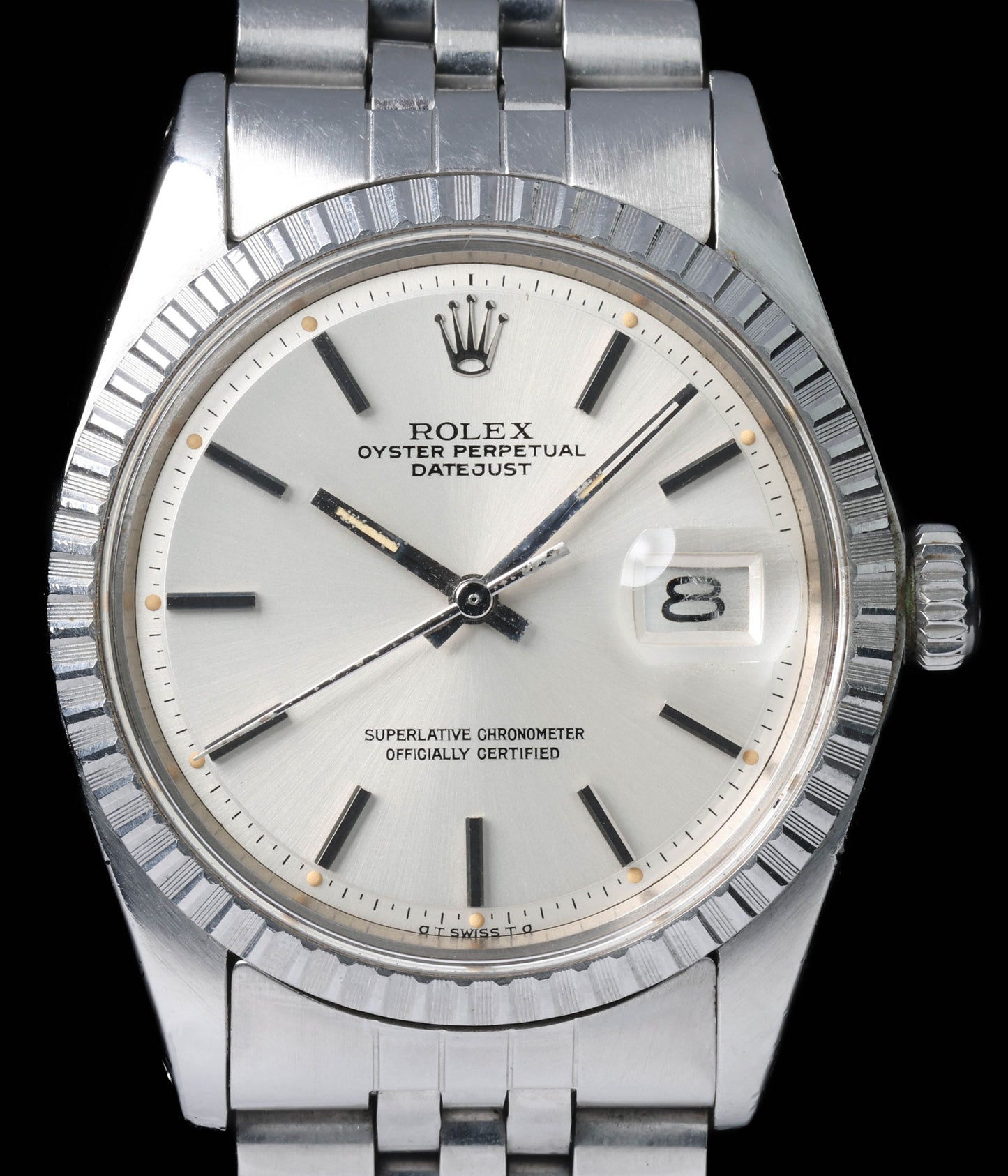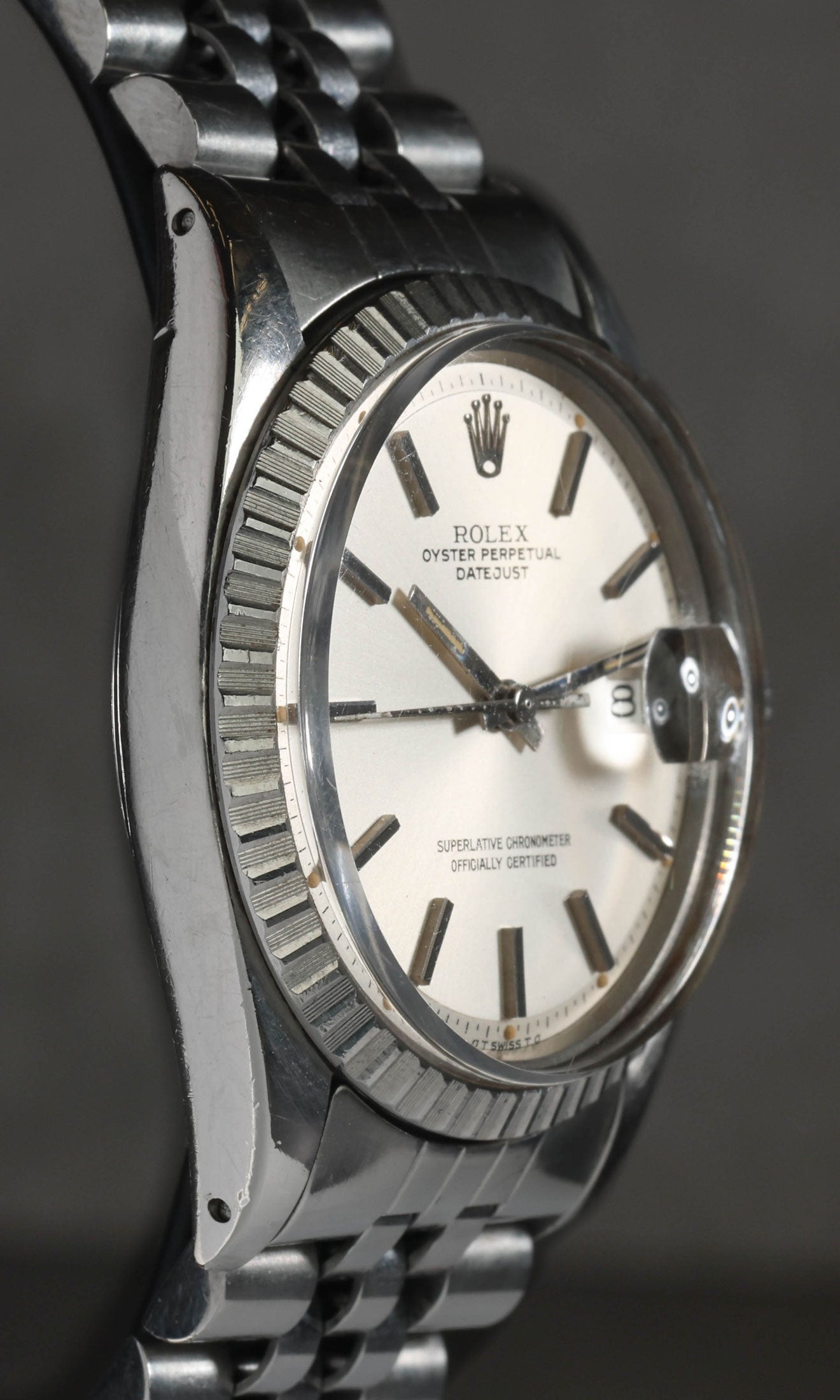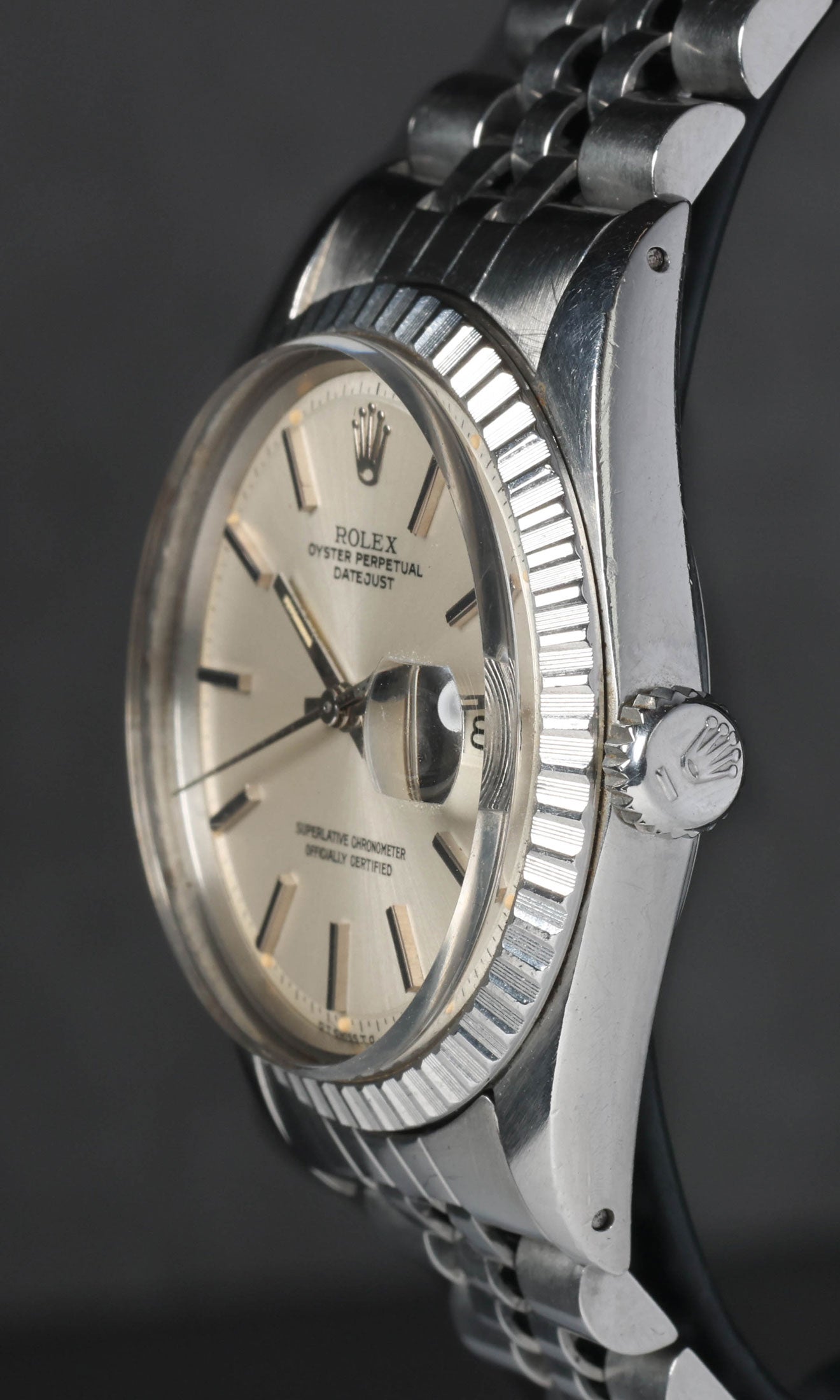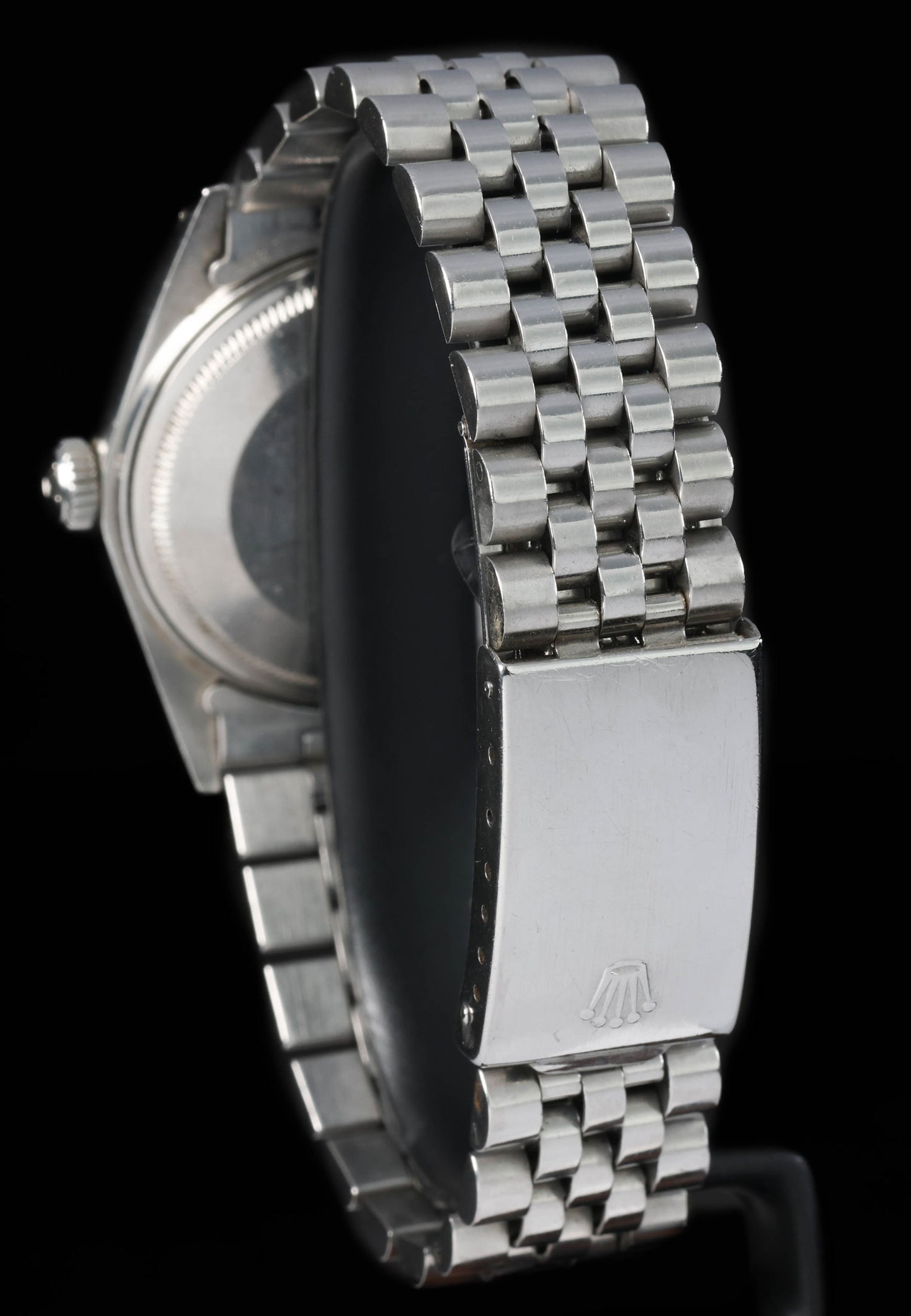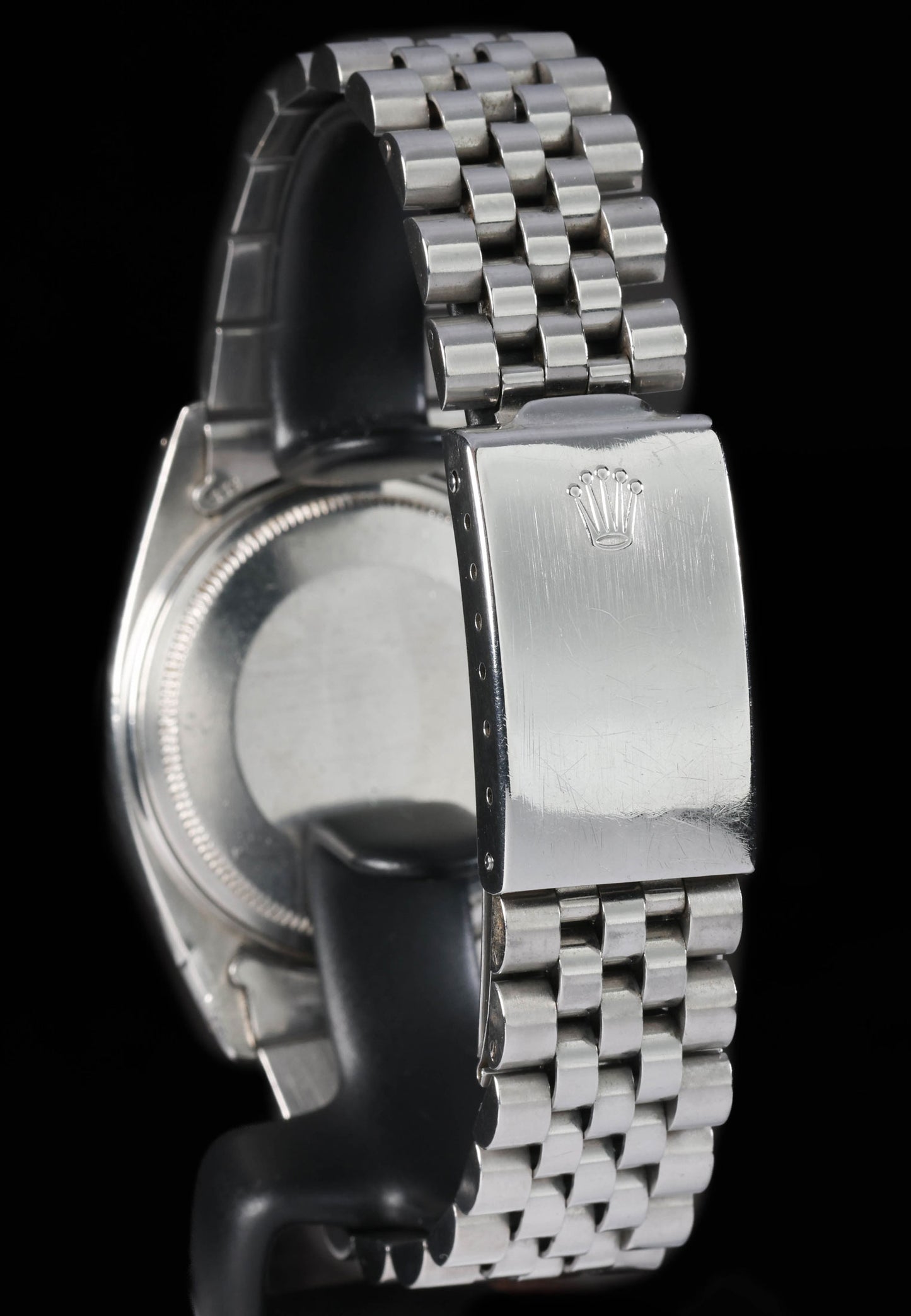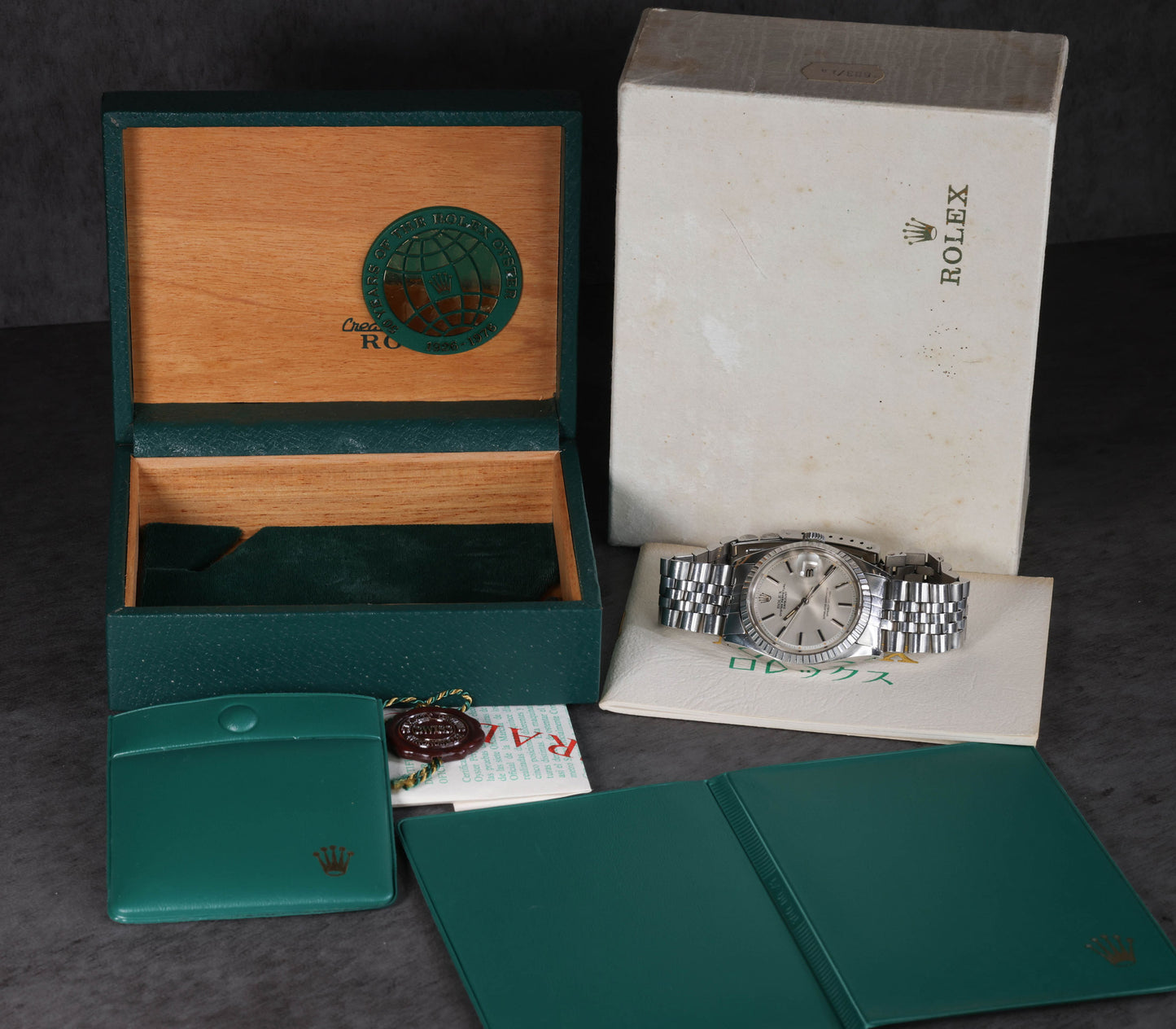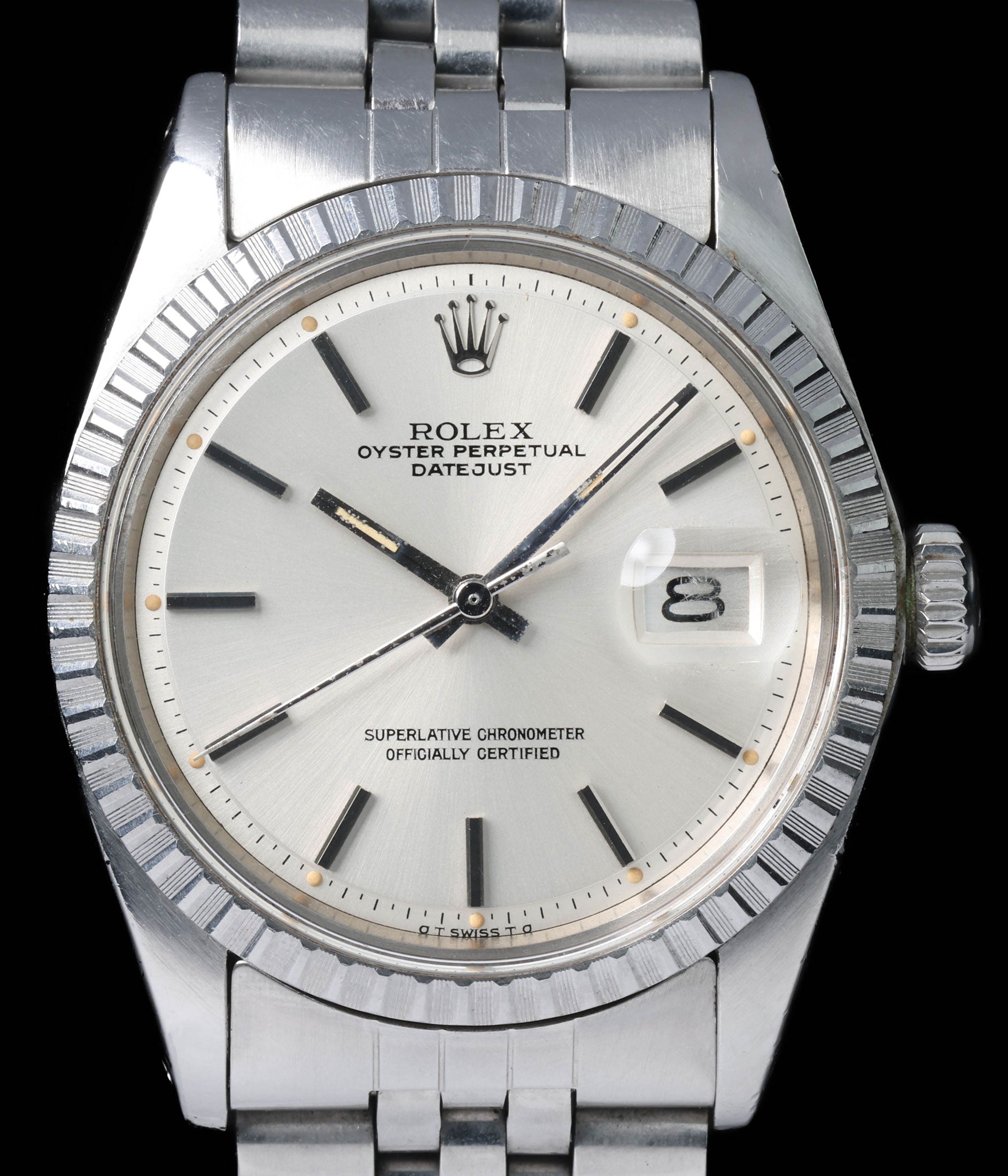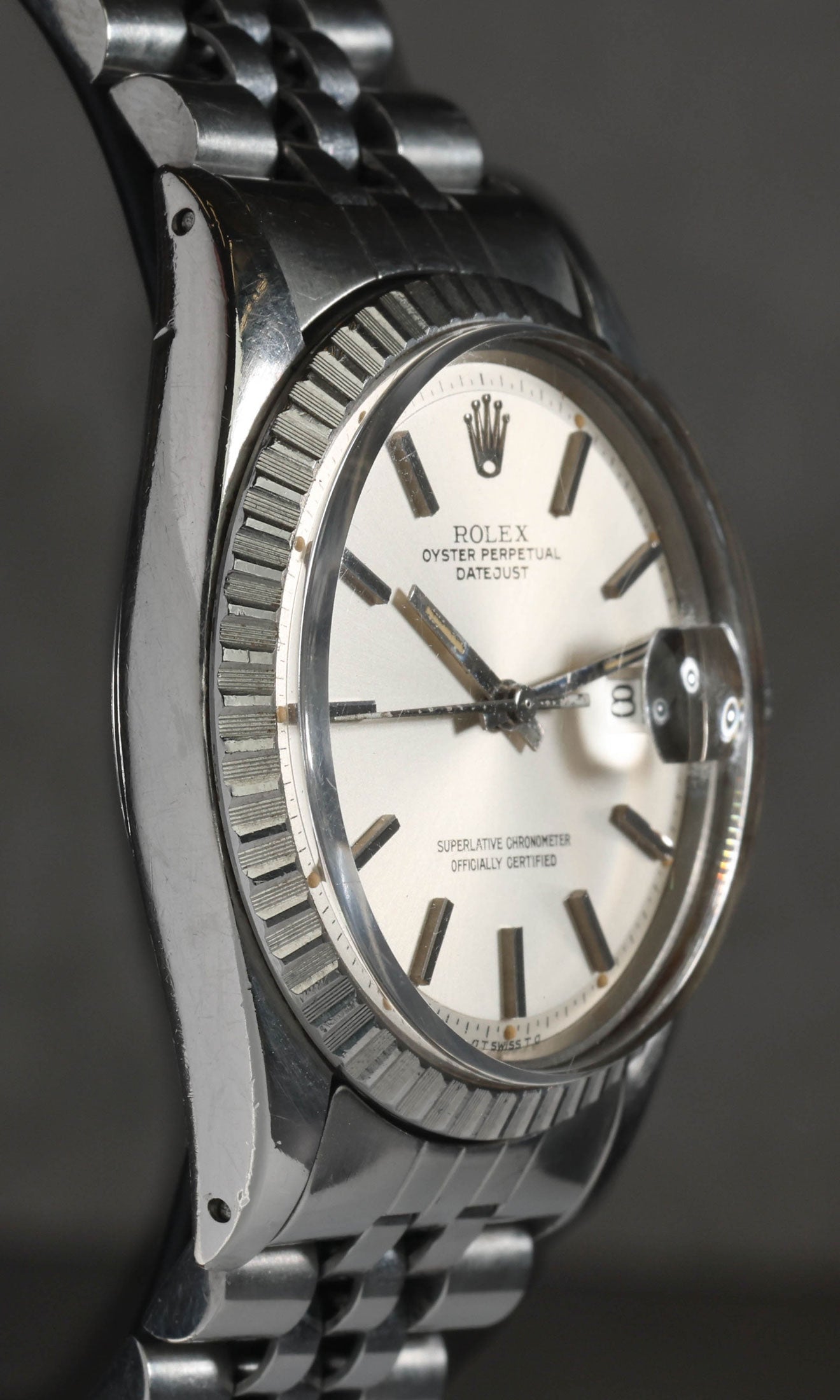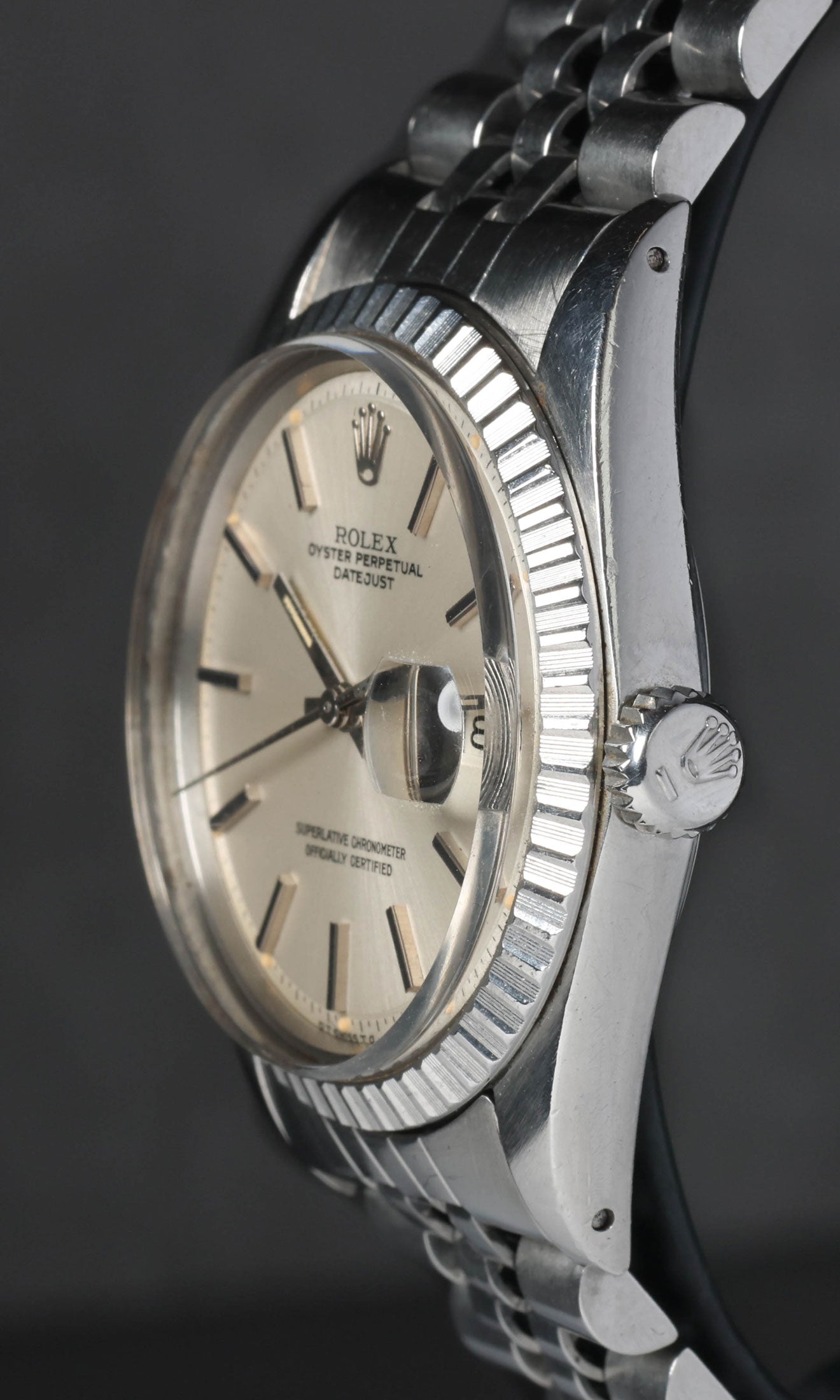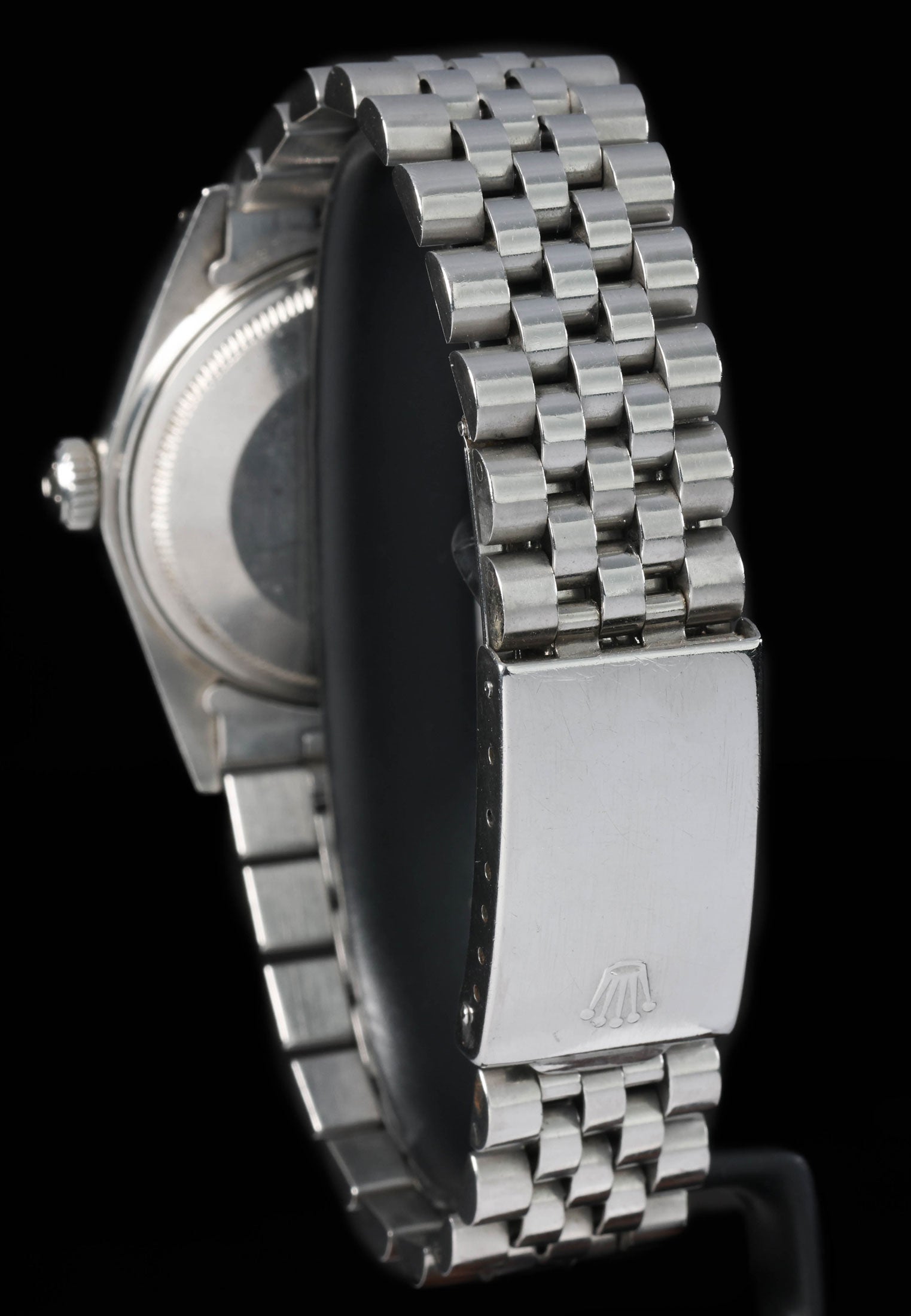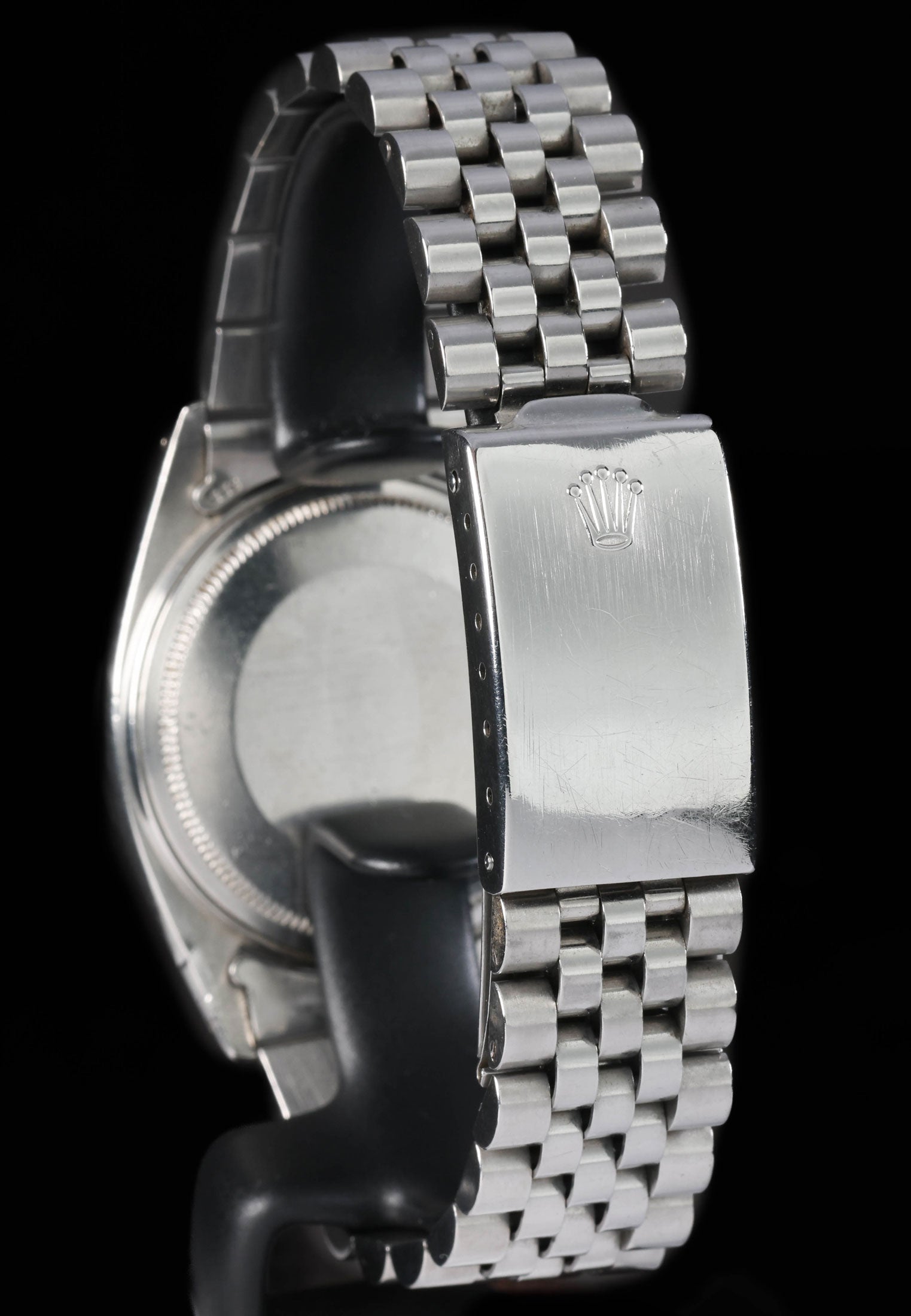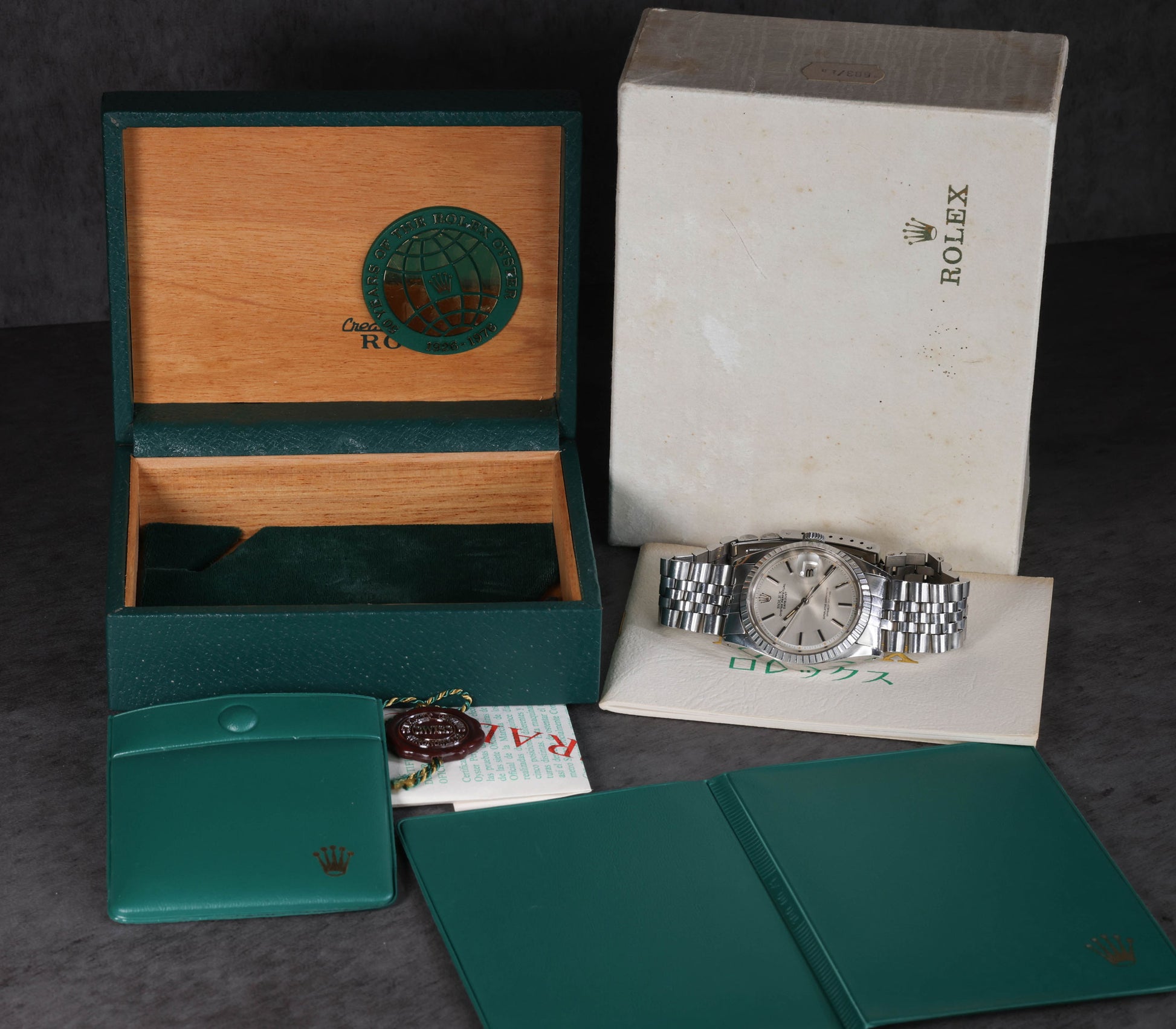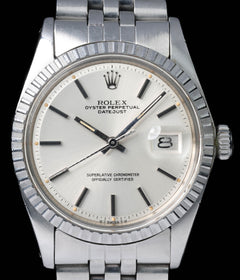Crown Vintage
Rolex Datejust 1603 'Sigma Dial' 36MM 1975
Rolex Datejust 1603 'Sigma Dial' 36MM 1975
Couldn't load pickup availability
Rolex Datejust 1603 'Sigma Dial'
Case retains strong original lines and presents in very good vintage condition, with light hairlines on both flanks and a small chip to the non-crown side that does not affect integrity. The engine-turned bezel remains crisp, and the acrylic crystal is clear with only minor surface marks appropriate to age. The steel Jubilee bracelet shows minimal stretch; end-links sit tight and only superficial hairlines are visible on the clasp and outer links. The original sigma dial is clean with intact tritium plots, while the hands display slight oxidation under magnification yet remain well-matched to the dial. As this watch is now 50 years old, it should be treated as a vintage timepiece—do not wear it while swimming or in the shower, even though it was built with Rolex’s Oyster water-resistant case.
Share
Why we love this watch
Why we love this watch
Rolex Datejust 1603 ‘Sigma Dial’ 1975: Timeless Steel Elegance
A brief origin story
Introduced in 1959, the reference 1603 took the core Datejust blueprint—automatic movement, instantaneous date jump at midnight and waterproof Oyster case—and gave it a robust, all-steel personality with an engine-turned bezel rather than the white-gold fluting of its sibling ref 1601. By 1975 the 1603 had become a quietly confident staple in the Rolex catalogue, sitting alongside newer references yet still relying on the proven Calibre 1570 automatic, a 36 mm case and the signature acrylic crystal. That continuity makes 1975 examples a useful time-capsule of mid-70s Rolex production methods, dial printing techniques and finishing standards.
1975 in context
Serial-number ranges place most 1975 pieces in the mid-3 million block. Rolex was refining dial fonts, luminescent paint mixes and bracelet tolerances yet had not moved to the quick-set Calibre 3035. The watch therefore represents the final flourish of four-digit Datejust engineering before the five-digit references debuted in 1977. Production volumes for 1603 remained healthy, but the survival rate of unmolested dials and bezels is lower than raw numbers suggest, largely due to everyday use and routine service replacements.
Understanding the Sigma dial
APRIOR and the birth of the σ mark
In 1973 Swiss industry consortium APRIOR trademarked the tiny Greek letter sigma (σ) to highlight the presence of solid gold components on a dial. Rolex adopted the mark a little earlier, printing σ T SWISS T σ at six o’clock to signal white-gold (or occasionally yellow-gold) hands and hour markers despite a steel case. The intent was protective branding: even on a relatively accessible model, these elements remained precious-metal parts.
Why sigma matters on a steel Datejust
Collectors label any dial carrying twin sigmas a ‘Sigma dial’, and on ref 1603 the detail appears from roughly 1972 through to the late 1970s. Because the practice ceased as the decade closed, a 1975 piece sits almost at the mid-point of the sigma era, making originality easier to verify. The combination of tritium lume plots (denoted by the ‘T’ either side of ‘SWISS’) and precious-metal furniture is a juxtaposition unique to this period.
Case and bezel: engineered restraint
The Oyster case remains 36 mm across, 20 mm between lugs and 11.7 mm tall with the domed acrylic crystal in place. Machined from 316L steel, it uses the 1600-series mid-case with twin-shoulder crown guards absent, preserving the traditional sweeping hood around the Trip-Lock winding crown. The bezel, milled with alternating polished flats and grooved ridges, gives the 1603 its instantly recognisable profile. Unlike later engine-turned bezels (which employed aluminium inserts), the 1975 bezel is solid steel, affording sharper edges and a muted, industrial sheen.
Pie-pan dial geometry
Four-digit Datejust dials retain the subtle dish-shape known as a pie-pan: the outer minute ring sits fractionally lower than the central field. This geometry, visible only at oblique angles, reflects 1960s dial-blank pressing methods. On sigma versions the applied baton markers are cut from white gold, then filled with tritium lume down their centre channels. The 3 o’clock aperture remains square, framed by a white-gold window. Correct 1975 printing features elongated serif fonts for “DATEJUST” and a flat-topped ‘A’ in “ROLEX”.
Calibre 1570 movement
Rolex’s Cal 1570 traces its roots to the 1959 Cal 1530 architecture, upgraded with a free-sprung Microstella balance, Breguet overcoil and cam-and-spring date change. Beating at 19,800 vph, it offers approximately 46 hours of power reserve. The movement is non-hacking until late 1971; most 1975 examples include the hack-seconds upgrade, allowing precise setting. A sturdy, full-bridge layout, indirect centre-seconds drive and KIF shock protection make Cal 1570 notably tolerant of everyday knocks. The rotor, machined from solid brass and rhodium-plated, runs on a jewelled ball-race, reducing service wear.
Wearing experience
Sizing and fit
At 36 mm the 1603 remains contemporary-friendly, suiting wrists that find modern 41 mm Datejusts overpowering. The Jubilee bracelet, reference 6251H for earlier pieces and 62510 for late-production, delivers plenty of articulation, helping the watch drape smoothly. The engine-turned bezel adds tactile tactility—its ridges catch light differently from fluted or smooth alternatives, giving the watch presence without overt flash. Weight, at around 80 g head-only, keeps balance centred, especially on the hollow-link Jubilee.
Legibility
The high-contrast baton markers on a silver or slate dial paired with the reflective engine-turned ring create sharp legibility in low light. The cyclops magnifier remains true to period specification at 2.5×, crisp and distortion-free at arm’s length. Acrylic adds a warm tint, subtly muting reflections that sapphire crystals can exaggerate.
Notable variations
Dial colours and textures
Although silver sunburst remains the archetype, 1975 catalogues list grey, blue, champagne and linen textures. Linen sigma dials, with their cross-hatch vertical and horizontal brushing, rank among the rarer species because the texture complicated print adhesion, raising reject rates during manufacture.
Lume tone
Tritium aged naturally over five decades to ivory, ochre or deep amber, depending on storage and wear. Uniformly coloured plots signal originality; stark white plots often indicate relume or service replacements.
Bracelet options
Period-correct steel Jubilee bracelets have folded links and 55 or 555 end-links. Oyster bracelets were an orderable option but remain less common. In 1975 Rolex still stamped bracelet clasp codes with quarter-year dating (e.g., “3 75”).
Provenance and popular culture
The 1603 rarely receives screen time compared with Submariners or GMT-Masters, yet its understated utility resonated with professionals who preferred discretion: academics, journalists and architects. Archival images show noted Italian industrial designer Achille Castiglioni wearing a steel Datejust on Jubilee bracelet during Milan’s 1970s design boom, aligning the reference with functional elegance rather than overt luxury.
Final thoughts
A 1975 Rolex Datejust 1603 ‘Sigma dial’ distils Rolex’s mid-70s engineering into a cohesive, daily-wearable package: engine-turned bezel for quiet character, pie-pan geometry for depth and the sigma signature as a discreet nod to precious-metal refinement. Combined with the Calibre 1570’s proven reliability and versatile 36 mm sizing, it remains a benchmark of timeless steel elegance—decades on from its debut and with design details that continue to set it apart in the broader Datejust lineage.
Case & Bracelet
Case & Bracelet
- Case in great vintage condition, hairlines visible around both sides. Small chip on non crown side of case.
- Bracelet in great condition, minimal stretch. Hairlines visible.
Dial & Hands
Dial & Hands
- Sigma Dial
- Dial & hands in great condition
- Hands lightly oxidised
Warranty & Condition
Warranty & Condition
Crown Vintage Watches provides a minimum 3-month mechanical warranty on pre-owned watches, from the date of purchase.
The warranty covers mechanical defects only.
The warranty does not cover damages such as scratches, finish, crystals, glass, straps (leather, fabric or rubber damage due to wear and tear), damage resulting from wear under conditions exceeding the watch manufacturer’s water resistance limitations, and damage due to physical and or accidental abuse.
Please note, water resistance is neither tested nor guaranteed.
Shipping and insurance costs for warranty returns to us must be covered by the customer. Returns must be shipped via traceable courier. Return shipment must be pre-paid and fully insured. Collect shipping will be refused. In case of loss or damages, the customer is liable.
Our Pledge
At Crown Vintage Watches, we stand by the authenticity of every product we sell. For added peace of mind, customers are welcome to have items independently authenticated at their own expense.
Condition
Due to the nature of vintage timepieces, all watches are sold as is. We will accurately describe the current condition and working order of all watches we sell to the best of our ability.
Shipping & Refund
Shipping & Refund
